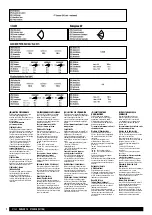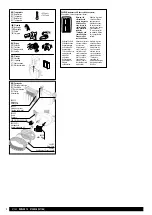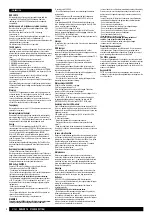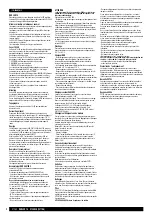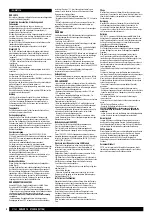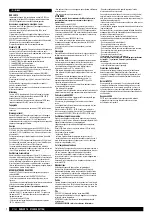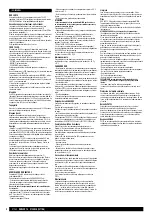
E72AC
DUOLED 14 E72503-C (131106)
(EN) ENGLISH
DUO LED 14
Waterproof with dual light source: focusable halogen bulb and
a regulated LED module. The DUO headlamp meets the
requirements of the 89/336/CEE directive on electromagnetic
compatibility.
Switching on & off, brightness selection, zooming
Move the switch up to select the powerful halogen beam - high
energy consumption (2).
Move the switch down to select the LEDs - low energy
consumption (3).
The zoom button allows focusing the high beam as needed. Turn it
down for a narrow spotlight, or up for a wider beam ().
The DUO LED allows you to optimize the power and duration of the
lighting according to your needs.
Simultaneous use of both bulbs is not possible.
14 LED module
The LED module is electronically regulated. The electronic current-
regulating system maintains constant brightness. It has a reserve
power mode that activates automatically when the batteries are nearly
spent, giving low-level proximity lighting and greatly extending burn
time.
In addition, the LEDs also provide 3 power levels.
. OPTIMUM: ideal balance between power and burn time.
2. MAXIMUM: maximum power.
3. ECONOMY: maximum burn time.
You may select the power level most suitable to your activity.
Move the switch down (on). The system is initially set to OPTIMUM.
To select the next lighting level (MAXIMUM), turn the switch off, then
immediately back on.
Consecutive off-on movements of the switch will cycle the light
through levels 2 and 3, then back to level again.
If the movement of the switch is not quick enough, the lamp will light
up at level .
When the batteries are nearly spent, the light automatically switches
to Reserve Power Mode, providing low-level lighting for an extended
period of time.
Warning
The DUO LED headlamp may interfere with the functioning of an
avalanche beacon. This can happen only when the LED module is
turned on, and the beacon is in receive (search) mode.
In case of interference (indicated by static noise from the beacon),
move the beacon away from the lamp until the noise stops, or switch
off the LED module and switch on the halogen bulb.
Topography
Warning, the electronics in the LED module can interfere with the
operation of a compass.
Unlocking/locking the bezel
Remember to lock the switch during transportation and storage by
pressing the red button (A). To unlock, press on the other end of
the red button (B). If the light accidentally turns on in your pack, the
heat produced by the halogen bulb can damage the lamp.
Energy
The E6500 2 DUO rechargeable battery (NiMh 2700 mAh) is
recommended for use with the SPELIOS. AA/LR6 batteries give a very
limited light duration when the LED module is set to maximum.
You may also use AA/LR6 rechargeable batteries (E60650).
With the LED module, a typical light duration given by the DUO
rechargeable battery is around 8 hours when multiple modes are
used, for example: 2 hours on Maximum, hours on Optimum and
2 hours on Economy.
Cold temperatures significantly reduce battery life. The LEDs often
give better light than the halogen bulb when the batteries are cold
or low.
Replacing the rechargeable battery
To open the battery case, unlock the two clips (5).
Warning, never remove the gasket ring inside the cover. Take care to
keep it clean and properly set in place (clean with water and a cotton
ball). Lubricate the ring with a silicone based grease. If changing
batteries in a wet environment, dry the inside of the box after use.
Prolonged storage: remove battery and leave box open.
DUO battery E65100 2
Capacity: 2700 mAh. The battery consists of four NiMh cells.
To be used only with the Petzl DUO CHARGER.
- The battery must be charged before first use.
- Do not hesitate to recharge a battery that is partially discharged or
that has been in storage for more than two weeks.
It is not necessary to fully drain the battery before recharging.
- Self discharging: a charged battery stored under good conditions
at 20 °C loses about 5 % of its charge after 3 days, then % per
day thereafter. Note that this rate of discharge is greater in higher
temperatures.
- Battery can be recharged 500 times.
- Always keep temperature at which battery is used between -20° C
and +60° C.
- Do not place the battery in a fire or dismantle it. An explosion or a
release of toxic materials may result.
- Do not short circuit the battery. It may cause burns.
WARNING
Completely drained NiMh rechargeable batteries may not perform
correctly or may even leak out gases and toxic chemicals.
To protect your ACCU DUO:
- Turn off the headlamp after each use and recharge the batteries
systematically.
- Switch to the economy LED mode when the light's brightness
decreases significantly and recharge the ACCU DUO as soon as
possible.
A completely drained ACCU DUO is detected by the charger as an
error: the charger will not work (the indicator light will be off). If this
occurs, we recommend the following:
- Let the ACCU DUO charge for 2 hours.
2- If it does not charge (if the indicator light is still off), force the
device to charge by unplugging it and then plugging it back in while
the ACCU DUO is on the charger base.
3- If the battery still does not charge (the indicator light remains off),
replace your ACCU DUO.
Storage
To extend the life of your battery, store it in a clean, dry place between
-20° C and +35° C.
DUO charger
- Do not recharge non-rechargeable batteries due to a risk of
explosion. Other types of batteries may burst causing personal injury
and may damage both batteries and charger.
- Batteries should always be charged at a temperature between 0 °C
and 0 °C.
- Do not expose to rain or snow, shock hazard may result.
- Do not operate the chargers if they have been subjected to a
significant impact or fall.
- If the chargers are damaged (the power cable for example), do
not disassemble. They must only be repaired in Petzl workshops as
special tools are required.
- To reduce the risk of damage to the plug, pull the plug and not the
cable when you are disconnecting the charger.
- Do not use with an extension cord.
- To avoid the risk of an electric shock, unplug the chargers before
attempting any maintenance or cleaning.
Mains charger E65200 2
A light is lit when the battery is charging.
Time for complete recharge: 3 h 30.
When the light flashes, the battery is fully charged. The battery
remains so if left in the charger (trickle charge).
You should leave the battery connected to the mains charger. So it is
always ready for use.
This 00-20 V~, 50/60 Hz charger can be used worldwide with
an appropriate adaptor plug (not supplied). It works with DUO
BATTERIES E6500 (00 mAh) and E6500 2 (2700 mAh).
Replacing a bulb or LED module
Open the headpiece using the left hand to unscrew the bezel (6). If it
jams, try a penetrating fluid, or warm the front cover with a hair drier.
Halogen bulb: unscrew the burned out bulb and screw in the new one,
tightening it securely.
LED module: pull the unit straight out (it’s OK to touch the LEDs).
Install the new unit.
To close the head piece:
- Grease the threads with a silicone based lubricant.
- Position the reflector, lens, and bezel correctly over the head
piece (7),
- Using your right hand, screw the bezel onto the head piece until
the mark on the bezel is situated between the two marks on the head
piece (8 & 9).
In case of malfunction
Make sure the batteries are good, and that they are properly installed
with respect to their polarity. If the polarity is simply reversed in the
battery case, the halogen bulb will work but the LEDs will not. Follow
the order and position as indicated on the battery case.
Try the spare bulb. Check the contacts for corrosion. If corroded,
gently scrape the contacts clean without bending them.
Work the switch several times.
If your lamp still does not work, contact PETZL.
Maintenance
Water in the headpiece or battery case can cause the lamp to
malfunction. Whenever the lamp has been used or opened in poor
conditions (moisture, mud, dust…), remove the batteries, bezel and
bulb. Allow the lamp to dry thoroughly, keeping the battery case,
bezel, and headpiece open. Clean the seals with water and lubricate
them with silicone grease.
Cleaning
Wash the lamp, with the compartments closed, in clean water. Use
soap for the elastic headband. Do not rub with an abrasive product
especially on the lens. Do not wash with a high pressure hose.
Batteries
DUO LED . Use alkaline batteries or NiMH rechargeables.
You can also use Lithium batteries, which are lighter and give longer
battery life in cold temperatures.
Attention: the use of Lithium batteries reduces the lifespan of
incandescent bulbs.
ATTENTION DANGER, risk of explosion and burns.
- The batteries must be inserted correctly w/respect to polarity by
following the diagram on the battery case.
If one battery is reversed (two + poles or two - poles in contact with
each other), a chemical reaction is produced in minutes that releases
explosive gasses and extremely corrosive liquid.
Indicator: a weak level of light with new batteries indicates that the
polarity of one or more batteries is reversed.
In case of doubt, turn off the lamp immediately and check the polarity.
Protect your eyes in case leakage has already occurred. Cover the
battery case with a rag before opening it to avoid contact with any
discharge.
In case of contact with liquid from the batteries, rinse affected area
immediately with clear water and get immediate medical attention.
- Do not mix brands of batteries.
- Do not mix new and used batteries.
- Remove the batteries from the lamp for prolonged storage.
- Do not recharge non-rechargeable batteries.
- Do not short-circuit the batteries as this can cause burns.
- Do not attempt to open or dismantle batteries.
- Do not put used batteries in a fire.
- Keep batteries out of reach of children.
PRECAUTIONS to avoid damaging your lamp (oxidation of
contacts...) and to limit the risk of leaky batteries:
- no not allow the batteries to become heavily discharged,
- keep water out of the battery case.
Protecting the environment
Lamps, bulbs, and batteries should be recycled. Do not throw them
in the regular trash. Dispose of these items by recycling them in
accordance with applicable local regulations. By doing so you play a
part in protecting the environment and public health.
The PETZL guarantee
This product is guaranteed for 3 years against any faults in materials
or manufacture. Exclusions from the guarantee: normal wear and tear,
modifications or alterations, incorrect storage, damage caused by
accidents, by negligence, by leaking batteries or by use for which this
product is not intended.
Responsibility
PETZL is not responsible for the consequences, direct, indirect or
accidental, or any other type of damage befalling or resulting from the
use of its products.


